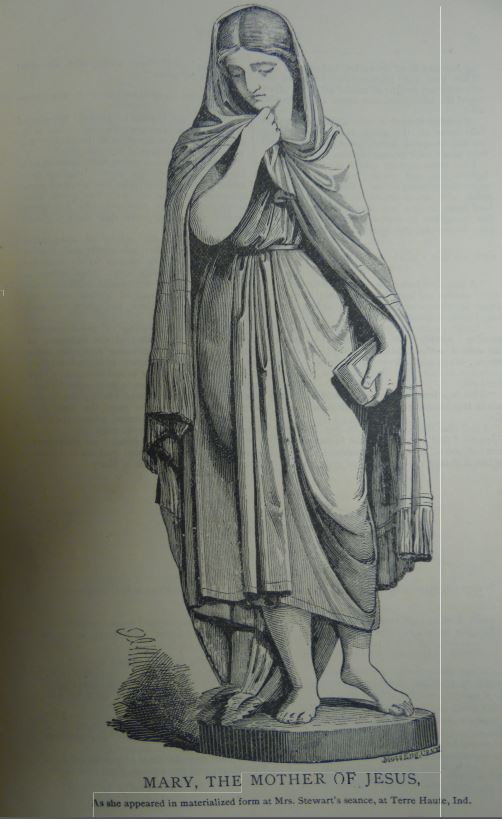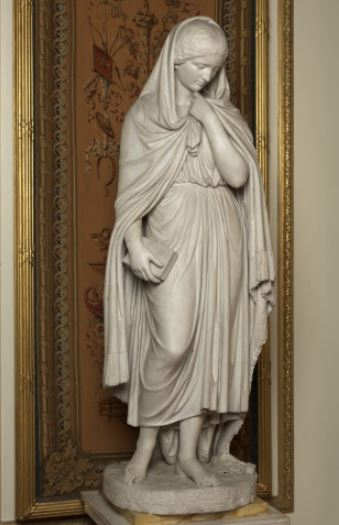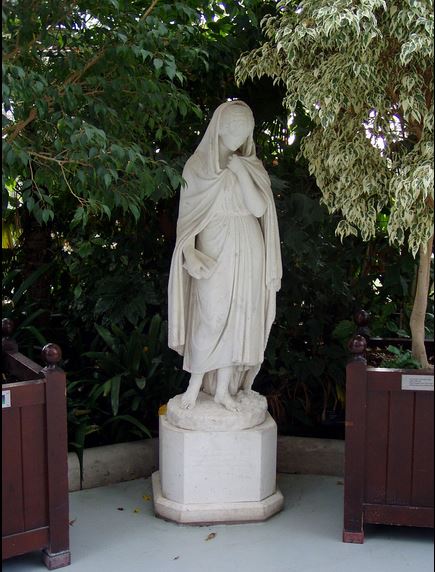A Photograph of the Virgin Mary

The Virgin Mary as she appeared at Terre Haute. http://www.iapsop.com/archive/materials/gallery_of_spirit_art/
I remember being impressed as a child by a photograph of St. Therese of Lisieux because, I thought, saints couldn’t possibly exist in a time when there was photography. The very idea seemed miraculous. Today we look at another “miraculous” image; that of the Virgin Mary, on a visit to Indiana.
Images of the Virgin Mary go back to the tradition that St Luke, disciple, author, physician, and artist—a veritable renaissance man—painted a portrait of the Virgin and the infant Jesus from life. A number of icons, mostly from the Eastern Christian tradition, are attributed to his brush. The tradition continues today with miraculous photographs from Međugorje and Conyers, Georgia. And just as Spiritualists adopted the new technology of photography to catch images of the dead, some mediums decided to edify the pious with snaps of the Virgin Mary. At a séance featuring Mrs. Anna Stewart, held at Terre Haute, Indiana in 1879, the Virgin Mary materialized, and, it was said, was photographed.
WHAT THE SCIENCE OF PSYCHOMETRY SAYS OF CERTAIN PHOTOGRAPHIC PICTURES OF MATERIALIZED SPIRIT FORMS
Taken at Mrs. Anna Stewart’s Circle, at Terre Haute, Indiana.
Letter from Hon. E. Lawrence, who was Present at the Spirit Circle When the Photographs Were Taken.
Editor of Mind and Matter:
I am indebted to the Hon. E. Lawrence, of Ann Arbor, Mich., for certain photographic likenesses of materialized spirit forms, taken at Mrs. Anna Stewart’s materializing circle, at Terre Haute, Ind. I received the photographs in June last. As two of these represent distinguished historical characters, I send to Mind and Matter, for public inspection and criticism, psychometric readings of those characters.
Judge Lawrence was present at Mrs. Stewart’s circle in January last, as will be seen by the following extracts from his letter to me, when the photographs were taken. His letter to me, inclosing the three photographic pictures, is dated April 14, 1879:
“As requested, inclosed I send you photographs of three pictures recently taken through the mediumship of Mrs. Stewart, at Terre Haute. One is said to be Mary, the mother of Jesus. This form appeared at the cabinet door. Minnie, the control, told me to go to the cabinet, feel of her bare feet, and see that she was standing on a tambourine. I did so. Minnie then said we could take her picture. The camera was brought into the séance room, the tintype placed in it, and the focus duly arranged. Raps then came on the cabinet door, and the slide on the camera was drawn. In three seconds or so the raps came again, the slide was closed and the plate was developed in the usual way. Mr. Stewart, when returning with the plate, exclaimed, “You have got an angel.” Thus was taken in a dark séance room, on a tintype, in three seconds, a picture which, for grace, beauty and loveliness, was never equaled by ancient or modern art. After the picture was taken the form came to the front of the platform and shook hands with Dr. Pence and myself. [The second photo, of St. Peter, barefoot, bearded, and holding keys, is then described.]
“The third picture is that of the medium, Mrs. Stewart, and an attending spirit. The spirit form came and sat by my side fifteen or twenty minutes, conversing on various subjects; then returned to the cabinet and appeared with the medium, as you see in the photograph. This picture shows that the medium did not personate them both.”
Mind and Matter 1 November 1879: p. 3
This photographic seance inspired an immense amount of controversy in the Spiritualist journals. Mrs Anna Stewart, like many mediums was accused repeatedly of fraud throughout her career. In 1876 she was examined by a committee of interested gentlemen, who concluded that she truly had materialized spirits and that their controls of the séance precluded fraud or a confederate. A short time later, one William W.H. MacCurdy wrote to say that the “Witch of the Wabash” had been unmasked by Victoria C. Woodhull in 1873: “Did she not have about her person false beards, gold bracelets, rings, masks, crowns, white clothing, etc., and did she not admit to having and using them in her wonderful materializations?” Indianapolis [IN] Sentinel 17 February 1876: p. 4
Still, Mrs. Stewart had her followers. The Spiritualist press devoted many column-inches to the controversy. For example:
Has the Spirit of the Virgin Mary Ever Appeared in Materialized Form?
Astoria, L.I., August 17th, 1880
Dear General:
I have read your article headed “Psychometry,” in Mind and Matter of August 14th, and feel, after its perusal that I should state what facts I have to sustain the correctness of the photograph, which the psychometric reading of those reliable mediums, James A. Bliss and Alfred James, reported to be that of the Virgin Mary.
It was at a private séance given by Mrs. Stewart, of Terre Haute, to Mrs. Hatch and myself, on the morning of November 19th, 1879, when the correctness of that photograph was fully confirmed. We had invited Judge Lawrence of Ann Arbor and J.B. Young of Chicago to join us, they being there at that time. The conditions that morning were very favourable, and the materializations were quite perfect and very remarkable.
The materialization of our daughter, with certain articles of dress, especially that of a lace sack [sacque, a loose jacket] which she then wore, stating it to be the counterpart of one she once wore, was something remarkable. The spirit, wishing to remove all doubts from our minds as to its identity, took off the sack, allowing us to handle and closely examine it, even stating that it was made of linen and silk. Now, I very much doubt if the duplicate could be found in the whole West, and yet that very article we held in our hands, notwithstanding the original was supposed to be locked up at our house in Astoria, L.I.
This circumstance is mentioned to verify the strength of the manifestations, that morning.
The third spirit form that came, purporting to be “Mary the Mother” –it beckoned for Mrs. Hatch to come to the cabinet, after greeting her with a kiss, the two came off the platform and standing by us spoke audibly, answering a number of questions—among them, this question was asked: “Are you the “Mother of Jesus?” [She] replied “Yes! I am his mother, he is my son, and was crucified on account of his mediumship.”
Then Mr. Young who had questioned the photograph, that had been given to Judge Lawrence as being a true representation—asked the spirit, if that was a true representation of herself? Replying in the affirmative—Mary, quickly stepping upon the platform and to the cabinet, removed a small tambourine, returned to us, placed it upon the platform, and stepped upon it, just as the photograph represents her standing; exactly materialized, in form and dress.
The quickness and energy with which the spirit verified the correctness of the picture was something too positive to leave a doubt, upon any one’s mind.
It must be understood, that Mrs. Stewart, the medium, was at all times visible to us, sitting in the cabinet. Now, in this instance, there could be no ground for deceiving spirits wishing to mystify, for none present, held that Mary was any more than all other personages recorded in history. Possessing such evidence, I felt it all important that I should place these facts before you, and do what little I could to sustain such earnest workers in the cause of Spiritualism as Dr. Buchanan, James A. Bliss and Alfred James.
Yours very truly.
A.L. Hatch.
[To which the editors of Mind and Matter replied with a certain amount of bland snarkiness:]
We know that Mr. Hatch has, with ourself, no purpose to promote anything but that which is true; and that he holds all matters secondary to that primary end. It is, therefore, in the kindliest spirit that we feel called upon to criticise the conclusions which he has formed relative to the true nature of a photograph, to which he refers, purporting to be a picture of the materialized spirit of the Virgin Mary, mother of Jesus Christ. We at the same time will in a most friendly spirit, correct Mr. Hatch’s erroneous idea that we have questioned the mediumship of Mrs. Stewart, Mr. Bliss or Mr. James, in what we have said in relation to the psychometrization of that photograph. What we said of Messrs. Bliss and James’s psychometrizations, we learned from them, and they both confirm the substantial correctness of what we published in relation thereto. Both mediums realized that they were but psychologically reflecting the mental action of Prof. Buchanan who held the photograph with his hand placed above their foreheads. Having subsequently seen and closely inspected the photograph in question, we were forced to conclude that it was a greatly reduced picture of the statue. Knowing this to be the fact, we were led to conclude that Messrs. Bliss and James were correct in their analysis. The influences exerted upon them by the mind of Dr. Buchanan, and that the latter, supposing that he held a photograph of the Virgin Mary in his hand, mentally impressed those mediumistic sensitives to reflect his thoughts in relation to that and other photographs which he submitted for psychometric reading at the same time….
The form is that of a young girl, poised in a most studiedly artistic attitude, and one too perfectly expressive of a single thought or emotion to be either natural for a spirit or a mortal. Besides, she stands upon the ever attendant accompaniment of the statue of a standing figure, a circular or oval pedestal, the shading of which showed that it was of precisely the same substance as the human form represented as standing upon it. About that fact there cannot be any doubt. This of itself is conclusive that the form represented was as lifeless as its stony or clayey support. But suppose this was not the fact, and suppose a spirit stood for the negative from which that photograph was obtained, and suppose it was the Virgin Mary’s spirit that stood for it, what conceivable reason was there for the Virgin Mother to play model artist, and mount a simulated pedestal in order the better to display her girlish graces?…. If it was a spirit who stood for that photograph picture, it was undoubtedly not the Virgin Mary, but some waggish and dishonest spirit, who sought to deceive those whom she could induce to regard her as some person of biblical importance….The Virgin Mary of the so-called Gospels, it is positively known, was none other than an allegorical personation of the Celestial Virgin, or Virgo of the zodiac, and the only virgin that ever was imagined to have given birth to the Son (Sun) of God—by priestly craft spelt Son instead of Sun.”
Mind and Matter [Philadelphia, PA] 28 August 1880: p. 2
This particular photo of “the Virgin Mary,” made with a suspiciously short exposure, was actually a photograph of a drawing of a statue, Benjamin Spence’s “Highland Mary,” based on the poem about one of Robert Burn’s ill-fated lovers.
There were three copies of the statue; one was bought by Prince Albert for Queen Victoria.

Statue of Highland Mary, Benjamin Spence, bought by Prince Albert for Queen Victoria https://www.royalcollection.org.uk/collection/2075/highland-mary
And another stands in the Palm House at Sefton Park.

“Internal, Palm House, Sefton Park (8)” by John Bradley – Own work. Licensed under CC BY-SA 3.0 via Wikimedia Commons – https://commons.wikimedia.org/wiki/File:Internal,_Palm_House,_Sefton_Park_(8).jpg#/media/File:Internal,_Palm_House,_Sefton_Park_(8).jpg
Note the “tambourine” base of the statues and the drawing. The drawing is reversed–perhaps that was supposed to be “proof” that it was not a drawing of the statue? As is the case with many Victorian spirit photos, it is difficult to understand how anyone could have thought this a photograph of a flesh-and-blood Virgin Mary. However, Mr. Hatch’s earnest defense of the photograph suggests the degree of willful disbelief available to some spiritualist champions, as well as the cynicism of a medium trying to pass off a well-known statue of a poet’s lover as the unspotted Mother of God.
Some things apparently never change. If you search for photographs of the Virgin Mary online, if they are not simulacra in clouds, they are obvious images of statues.
Any other 19th or early-20th-century photographs of the Virgin Mary? Expose for 3 seconds and send to chriswoodyard8 AT gmail.com
Chris Woodyard is the author of The Victorian Book of the Dead, The Ghost Wore Black, The Headless Horror, The Face in the Window, and the 7-volume Haunted Ohio series. She is also the chronicler of the adventures of that amiable murderess Mrs Daffodil in A Spot of Bother: Four Macabre Tales. The books are available in paperback and for Kindle. Indexes and fact sheets for all of these books may be found by searching hauntedohiobooks.com. Join her on FB at Haunted Ohio by Chris Woodyard or The Victorian Book of the Dead. And visit her newest blog, The Victorian Book of the Dead.
